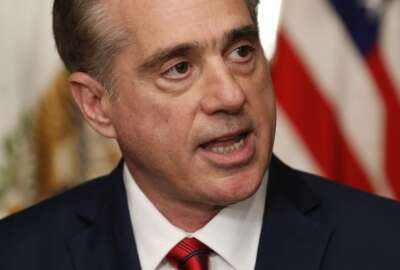
Shulkin to release ‘State of VA’ report amid reorganization efforts
The Veterans Affairs Department is preparing a "State of VA" report on the challenges facing the agency, Secretary David Shulkin told reporters Wednesday. The...
The Veterans Affairs Department is preparing a top-to-bottom review of the challenges VA leadership sees in the department. Secretary David Shulkin told reporters Wednesday he hopes to release the “State of VA” report in two or three weeks.
The report will come as the department continues to review its functions and offices in preparation for the Trump administration’s government reorganization efforts.
Agencies must submit reform plans to the Office of Management and Budget this summer, but VA says it would like to move more quickly. Shulkin already announced his intention to shrink the size of VA’s corporate central office, which he said will be one part of the department’s reorganization efforts.
Other solutions are coming.
“We’re looking to move toward more shared services rather than siloed services in each of our administrations,” Shulkin said during a House Appropriations subcommittee hearing May 3. “We’re actually looking across federal agencies to see — are there things that maybe other agencies are doing better that they should be doing for us or vice versa, whether VA should be taking on some of the functions that other agencies are doing. We’re working with other secretaries on that.”
The department’s reorganization efforts and “State of VA” review also come at a pivotal time for the agency. It has about six months to present a new plan to Congress for “Choice 2.0,” Shulkin’s self-described strategy to streamline VA’s Choice and Community Care programs and integrate more private sector options, before funding dries up at the end of the year.
The future of that plan will also depend on the budget.
President Donald Trump’s “skinny budget” proposes significant increases to VA’s budget in fiscal 2018, a $4.4 billion — or 6 percent — increase in discretionary funding over the previous year. Congress has consistently given VA more and more over the past nearly 10 years: VA discretionary funding has grown from $43.6 billion in 2008 to $74.3 billion in 2017.
Yet Congress is concerned that this trend will continue, and some lawmakers said they haven’t seen the progress they’d like that would merit a 6 percent funding increase.
“While we are providing additional resources, we’re not seeing what would normally come as the commensurate response from the people receiving these services because of the challenges that the VA is having in providing those services efficiently,” said Rep. Debbie Wasserman Schultz (D-Fla.), ranking member of the House Appropriations Military Construction, Veterans Affairs and Related Agencies Subcommittee.
Shulkin said the extra funding is necessary, in part, because more veterans are asking for authorizations under the Choice Program. VA issued five times as many authorizations in fiscal 2016 than it did in fiscal 2015, he said. It gave 35 percent more authorizations for Choice in the first quarter of 2017 than it did during the first quarter of the previous year.
“I am not looking for non-sustainable increases year after year the way that we have in the past,” Shulkin said. “The problems that we have in the VA are not primarily financial. These are primarily system issues that we haven’t kept up with and we haven’t modernized. I am looking for an investment this year.”
At the same time, VA is pursuing cost-cutting measures. The department is discussing how it can eliminate or sell 431 empty buildings and repurpose some 735 more under-utilized facilities. Those buildings cost VA $25 million a year to maintain, Shulkin said.
The budget boost would also help VA attract and retain top talent to fill roughly 49,300 vacancies, Shulkin added. The Veterans Health Administration alone has 45,000 clinical vacancies, and 1,500 of them are mental health positions.
“The crisis that we went through and the lack of good press [and] the impact of the morale on the workforce has really hurt us in recruiting,” he said. “Of course we had a hiring freeze in place up until April 12, so we have fallen behind.”
VA may eventually return to Congress and ask for additional funding for its future IT modernization project, Shulkin said, but that request won’t come until the department has made an official decision about the direction it would like to move.
VistA vs. something else?
Shulkin acknowledged the deep frustration members of the subcommittee have felt over the millions of dollars Congress has given VA to develop the Veterans Information Systems and Technology Architecture (VistA), which has yet to deliver an electronic health record that’s interoperable with the Defense Department.
By July 1, the department will decide whether a vendor will take over and support VistA or if VA will buy a completely different off the shelf product, Shulkin said.
“The VistA system is something that, frankly, VA should be proud of,” he said. “It invented it. It was the leader in electronic health records, but, frankly, that’s old history. We have to look at keeping up and modernizing the system.”
DoD in 2015 awarded a multi-billion dollar contract to a consortium of companies for a new electronic health record. VA, however, has maintained a separate path, and multiple members weren’t shy in expressing their exasperation with VA on this topic.
“If Gen. Mattis has a better idea than you do, will you agree to go to his program just to get this moving?” said Rep. Tom Rooney (R-Fla.). “You could be the best VA Secretary of all time if you solve this problem. Every time we sit up here and talk to people at this table, we always keep asking the same question. I know there’s a lot of bureaucracy, and I know that there’s a lot of pride … but … if it means you saying to Mattis, ‘You know you’re right, you have a better program, we’re going to go with your program,’ will you do it?”
Shulkin said VA is open to anyone’s idea on the interoperability issue and that he was “exploring all options.”
“The answer to your question is yes,” he said. “We want to resolve this issue in the best way, and if it means taking somebody’s else’s idea, we’re going to do that.”
Copyright © 2025 Federal News Network. All rights reserved. This website is not intended for users located within the European Economic Area.
Nicole Ogrysko is a reporter for Federal News Network focusing on the federal workforce and federal pay and benefits.
Follow @nogryskoWFED





